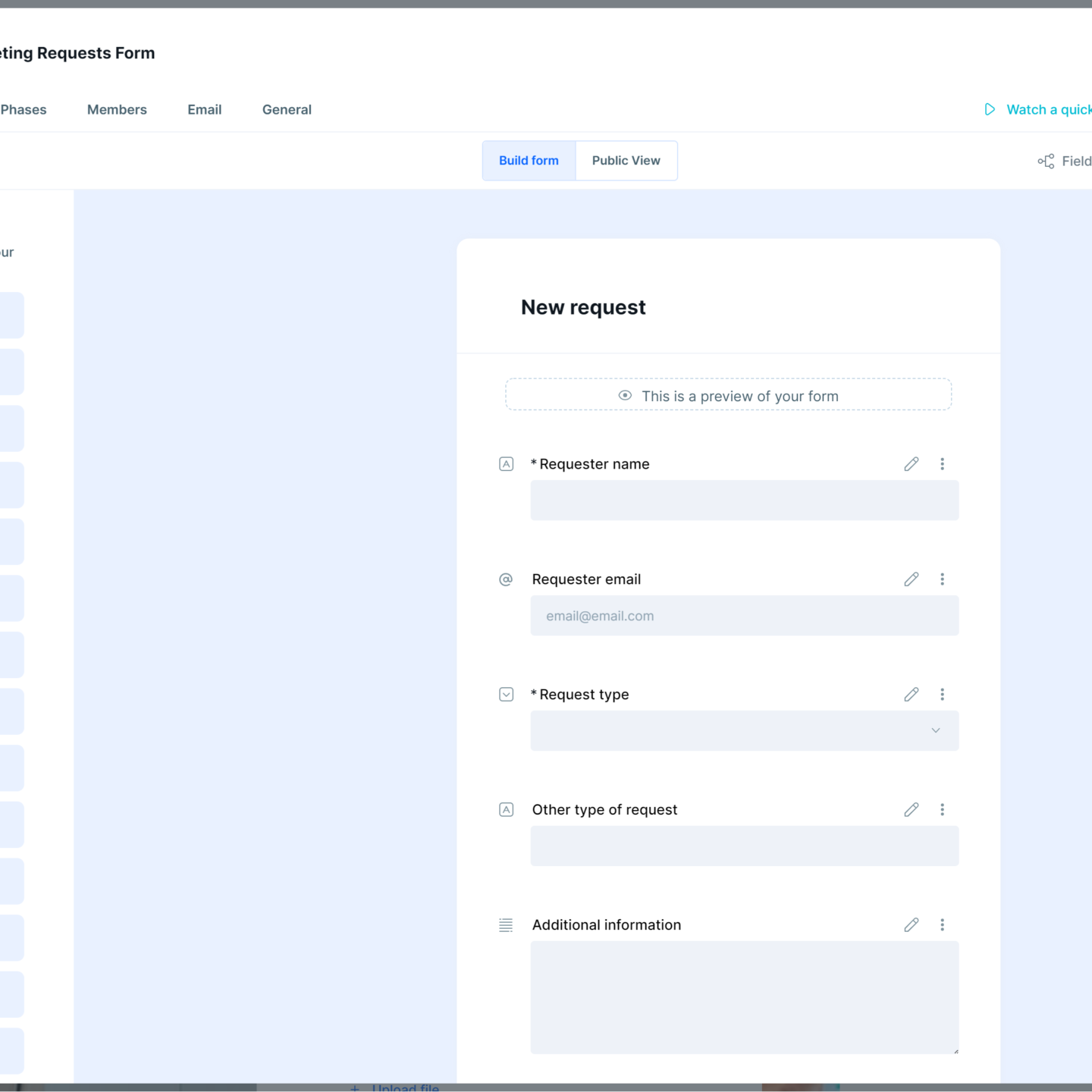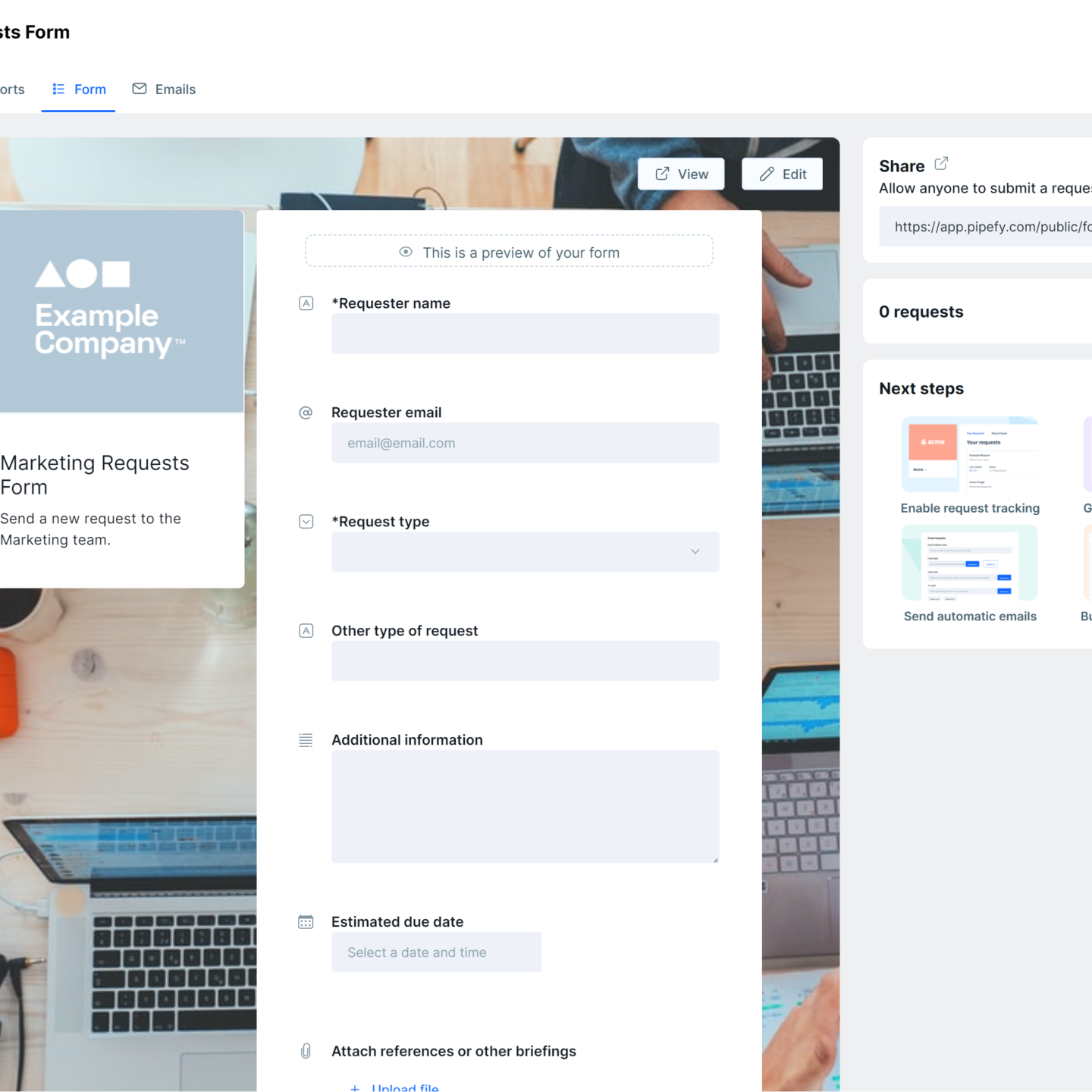ARTICLE SUMMARY
A custom marketing request form will grant all the information you need when clients ask your team for a campaign or an asset. See how to create them.

According to a SEMRush survey, 84% of all organizations have a content marketing strategy, but only 11% of the companies evaluate their method as “excellent.” Having clear and structured marketing briefings is at the core of what it takes to achieve efficient content and marketing deliverables.
This article will show how a good marketing request form is the first step to achieving an excellent marketing strategy. The accuracy and details in your forms can determine the performance of a content piece, event, or campaign — plus help your team work faster and with less effort. You’ll also learn how to use a ready-to-go marketing brief template and solve your briefing deficiencies immediately.
What is a marketing request form?
A marketing request form is a document in which an internal or external client asks for a specific asset or campaign and provides details of how it should look and where it should be published, apart from sources, references, design assets, etc. These requests might be made via paper forms, emails, or online forms.
Some teams arrange meetings to discuss the briefings they receive, but it’s easy to lose a lot of time this way and we don’t recommend it except in complex cases. Ideally, forms should include precise and valuable information, allowing the marketing department to have all the information they need to get started.

Forms also allow marketing requests to be traceable and more transparent. This way, there’s always a clear requester and an assigned team (or assigned person) to take care of it.
There are different types of request forms applicable to a marketing department: content request forms, marketing project request forms, creative request forms, design request forms, campaign request forms, event request forms, and so on. Typically, the information that needs to be provided encompasses the following:
- Name of the requester
- Assignee for the job
- Email address
- Departments
- Scope of the job
- Reason for request
- Necessary budget (if applicable)
- Design assets (if applicable)
- References
- Format
- Start date
- Due date
- Channel(s)
- KPIs and objectives
- Attachments (references, documents, complementary assets, etc)
Marketing request forms: 5 benefits of adopting a structured way to receive requests
Putting energy into implementing a structured marketing request forms system has a series of benefits. With well-built forms, your team can finally get complete information from stakeholders and improve visibility over the marketing processes. Find below a list of this tool’s main advantages:
- Improves visibility for requesters: Forms pack information so it is easier to understand where the request is coming from and which team is asking for a specific project or content. Plus, many form tools will also email the submitter confirming data receipt and provide them a copy of all information provided.
- Easier to track requests: With organized requests, tracking the status of each demand is simple, especially when the form sets clear deadlines and specific goals.
- Ensures information is accurate and complete: Forms eliminate rework when it comes to gathering information. If you choose the proper fields and set them as mandatory, the respondents will need to provide the data you need to kick off the project.
- Saves time and money: Since complete information is always provided, the marketing team won’t need to reach out to the requester to ask for missing information or documents. Besides, forms save time from extensive meetings to detailed marketing briefings, which are very common when teams don’t have any organized process.
- Facilitates process organization: Forms gather information so that it’s easier to connect them to an efficient workflow. You’ll be able to define which information is necessary as an input for each process and work on them in a structured and optimized way.
Structured briefing + uncomplicated workflows = receipt to success
Many platforms such as Google, Typeform, and Jotform offer free forms builders that allow you to create and customize forms, choosing the most appropriate fields, colors for the templates, etc. However, these tools don’t offer a complete solution to a marketing process at scale because they don’t connect these forms to workflows.
Since this integration is not possible, marketers need to manually transfer data received via forms to spreadsheets or workflow software, risking the integrity of the entire process and losing time with this activity.
However, some tools offer an integrated solution, where you can connect the answers from the forms directly to a structured workflow. The significant advantage is that your team wouldn’t need to transfer data. Moreover, a workflow software usually allows users to automate process steps, accelerating the work, and ensuring an error-proof process.
The connection between a form and an automated workflow allows assigning the project/campaign/piece of content to a specific team or worker depending on its scope. Or notifying the stakeholders each time the request progresses in the workflow (when it’s ongoing, on hold, ready-to-go, etc), saving time from unnecessary emails or meetings.
How to create your marketing request form and manage your team’s workflow
Choosing the best tool and connecting forms to a workflow has little use if one’s team doesn’t follow best practices to create and run marketing forms as efficiently as possible. Below are some essential steps you will possibly have to go through to ensure your marketing forms will work as expected:
1 – Create the form
After considering all tools, their capabilities and limitations, it’s time to design and create your form. Select the most appropriate fields to compose your marketing form, according to each type of deliverable (campaigns, events, design assets, ads, articles, etc).
Don’t forget to review your questions/requests and to set as mandatory fields the ones that must be necessarily filled in — do not simply set all fields as mandatory by default. Try to keep it short and direct and to leave a field for additional comments and suggestions.
2 – Educate your team
Once the form is created, educate your team about how it works and, if necessary, your internal clients. Collect feedback from your colleagues and promote learning sessions to explain how to integrate the form with the current marketing process. One good practice, for instance, is to avoid further meetings or calls if all the necessary information was already provided on the form.
3 – Standardize workflow phases
Now that you have your form, take a look at your workflow. Assuming you chose a tool that connects the answers from the forms to a cloud-based workflow (such as Pipefy), you can add automation to your process and define specific forms for each phase of your workflow.
Suppose the request is on hold, for instance. In that case, you can implement a specific automation on the cards (each card represents one request) requesting additional information via email, without the need to manually open your mailbox and write a message from scratch to the requester.
4 – Analyze your team’s results
With a standardized workflow fed by forms, your marketing process can continuously improve. It depends on feedback from the team and practical results that you will probably be able to follow just by running your everyday operation. Pipefy offers comprehensive reports and dashboards that can be extracted immediately and help leaders evaluate the efficiency of their forms or the process as a whole.
Examples of marketing request forms
How can marketing forms be structured? Before collecting the information you need, you have to carefully build your forms, add the relevant fields, and customize their appearance. Find below two examples of ready-to-use marketing request form templates from Pipefy’s gallery:
Campaign briefing form
The Campaign Briefing Form encompasses suggested fields that boost intake collection in one place and in a standardized way. You can add more fields and connect this input directly to your workflow, saving time and resources from your team. It’s also possible to customize it, add your company’s logo, name the form, and change the background colors.
Here’s some relevant information that can be gathered through this form:
- Requester’s name
- Requester’s email
- Campaign name
- Briefing
- Main goals
- Targeted audience
- Estimated budget
- References

Click here to start using this campaign briefing form for free.
Marketing requests form
Leverage this template to collect marketing requests at scale and connect them directly to your marketing workflow. With this form, you ensure all critical information is submitted, and you can use Pipefy’s no-code features to automate communication and update your internal or external clients as their requests are processed without manually sending them emails. Here are some relevant fields that are part of this form’s template:
- Requester’s name
- Requester’s email
- Request type
- Additional information
- Estimated due date
- References
Remember that after selecting this form in Pipefy’s template gallery, you can also change its colors, name, and logo, besides choosing more fields to compose it.
How one of Brazil’s largest retail chains creates 3,000 marketing assets per month with a team of 10 in-house professionals
Forms can transform the way companies handle marketing requests, eliminating common errors, and increasing the efficiency of the whole process. Magazine Luiza, also called Magalu, is one of Brazil’s largest retail chains, and leveraged this solution to streamline marketing deliverables.
Magalu’s Design and Branding Studio was created in 2018 to take care of the company’s visual and verbal communication, and they used to struggle with a management tool that did not centralize all the information and activities, leading to poor communication and misunderstandings about instructions. As a result, 47% of the briefings received by Magalu’s marketing team did not provide all the details they needed to start the work.
After they decided to adopt Pipefy, the situation shifted completely. Thanks to Pipefy’s forms, they started to collect briefings and requests through a single tool to streamline the process. The solution eliminated rework and the lack of standardization. Every requester who sends a briefing needs to fill in all the information regarding the request, which improves productivity and assertiveness. Now, only 31% of all briefings received need additional information.
Automation was another benefit, increasing the speed of deliverables and avoiding process errors too. In the first semester of 2020, the team was using 3,800 automated actions, while in the second semester, this number rose to 16,400 automation. Read Magazine Luiza’s complete case study.
Say goodbye to incomplete briefings
Transform the way your time handles marketing requests. Pipefy is a no-code platform that allows you to create accurate forms, capable of collecting complete information from your clients and turning them into effective marketing campaigns, events, and assets. Stop wasting time because of errors and miscommunications: connect your marketing requests to digital workflows that are easy to build and run — and no information will be lost.










